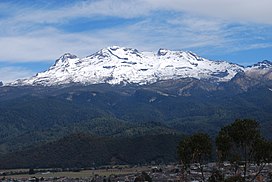| Iztaccíhuatl | |
|---|---|
 Iztaccíhuatl from Amecameca | |
| Highest point | |
| Elevation | 5,230 m (17,160 ft)[1] |
| Prominence | 1,530 m (5,020 ft)[2] |
| Listing | |
| Coordinates | 19°10′44″N 98°38′30″W / 19.17889°N 98.64167°W[1] |
| Geography | |
| Location | México and Puebla, Mexico |
| Geology | |
| Volcanic arc/belt | Trans-Mexican Volcanic Belt |
| Last eruption | Holocene[1] |
| Climbing | |
| First ascent | 1889 by James de Salis |
| Easiest route | rock/snow climb |
Iztaccíhuatl or Ixtaccíhuatl (both forms also spelled without the accent) (Nahuatl pronunciation: [istakˈsiwat͡ɬ] or, as spelled with the x, [iʃtakˈsiwat͡ɬ]) is a 5,230 m (17,160 ft)[1] dormant volcanic mountain in Mexico located on the border between the State of Mexico and Puebla within Izta-Popo Zoquiapan National Park. It is the nation's third highest, after Pico de Orizaba at 5,636 m (18,491 ft), and Popocatépetl at 5,426 m (17,802 ft).
The name "Iztaccíhuatl" is Nahuatl for "Sleeping woman", reflecting the four individual snow-capped peaks which depict the head, chest, knees and feet of a sleeping female when seen from east or west. Iztaccíhuatl is to the north of its twin Popocatépetl, to which it is connected by the high altitude Paso de Cortés. Depending on atmospheric conditions Iztaccíhuatl is visible much of the year from Mexico City some 70 km (43 mi) to the northwest. The first recorded ascent was made in 1889, though archaeological evidence suggests the Mexica and previous cultures climbed it previously. It is the lowest peak containing permanent snow and glaciers in Mexico.
- ^ a b c d "Iztaccíhuatl". Global Volcanism Program. Smithsonian Institution. Retrieved 2010-06-22.
- ^ "Volcán Iztaccíhuatl". Summits of the World. peakbagger.com. Retrieved 30 June 2010.

